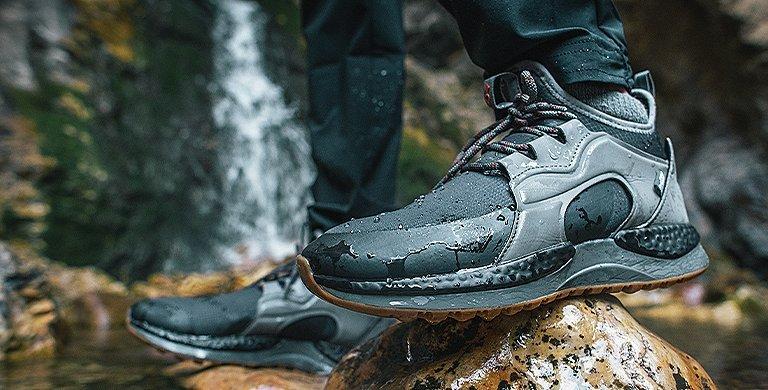GEAR
6 WAYS TO MAKE YOUR
OUTDOOR GEAR LAST LONGER
We’ve all been there before: it’s the beginning of the season and whether you’re skiing, hiking, camping, or backpacking, the impulse to run out and buy a bunch of new gear is practically irresistible. It’s exciting, after all. You’re ready to hit the slopes or explore the wilderness. What could be more fun than doing it with a bunch of shiny new gear? But you don’t have to be trapped in an endless shopping cycle. Sure, it’s fun to splurge every now and then but buying outdoor gear doesn’t have to be an annual expenditure. It’s built to be rugged and durable. You just need to know how to take care of it. Check out some of the tips below for making your outdoor gear last.
1. STORE IT PROPERLY
You’d be surprised how much of the wear-and-tear that your outdoor gear receives actually occurs indoors. To minimize this, read the care instructions thoroughly when you purchase a new item and make sure you know how to store it properly. Sleeping bags, for example, should be kept in loose mesh bags, not in their stuff sacks. This allows them to breathe and prevents the loft from being compressed. The same is true of puffy jackets or other loft-based apparel. Keeping things dry is another important factor. You don’t want to shove a wet backpack in the back of your closet or leave your base layers wadded up at the foot of your bed—this will encourage mold, mildew, and odour. Also be mindful of temperatures as some fabrics are sensitive to heat and cold.
2. KEEP IT WATERPROOF
When you first buy a raincoat or waterproof gloves, you can practically wear them in the shower. Everything is brand new and the waterproofing is shiny and crisp. Over time, however, it starts to become less effective. The coat that once could have kept you dry through a tropical monsoon suddenly starts leaking at the cuffs. This is partly because lots of waterproof gear gets its effectiveness from a coating called DWR (Durable Water Repellent). After time, this starts to wear off and water starts seeping in. The good news is that you can buy DWR in a bottle. It’s available in a spray-on version, as well as a liquid wash that you can run through the washing machine. Treating your waterproof gear regularly will make it last longer—just be sure to read the instructions so you know that your specific item is compatible with that wash or spray. Alternatively, you can buy DWR-free gear such as Columbia Sportswear’s Outdry Extreme jackets. These don’t have coatings that can wear off and tend to last longer to begin with.
3. CLEAN IT REGULARLY
Outdoor gear is made to get dirty but that doesn’t mean it should stay that way when it’s not in use. It’s difficult to overestimate the importance of cleaning things off each time you come inside. This prevents dirt and grime from getting stuck in zippers, hardening in buckles, or lodging in between parts. It also stops sand, grit, and other abrasive elements from eroding the fabric. If you don’t do this, caked dirt can dry out the material and tree sap or other sticky substances can cause things to malfunction. Be sure to always give your outdoor belongings a thorough cleaning after every use.
4. DON'T ABUSE IT
People often think that because these items spend time outdoors, it’s fair game to thrash them all over the place. But just because something is meant to withstand lots of wear-and-tear doesn’t mean that you have to toss it in the mud, whack it against a tree branch, or kick it around on the ground. Take a minute to consider your gear when you’re outside. Keep things off the ground when possible. Try to avoid brushing against trees, rocks, and other obstacles. Don’t bang coolers against the concrete and use the proper handles on backpacks and duffle bags to avoid putting strain on the stitching.
5. MEND IT FIRST
A broken buckle doesn’t have to mean running out to the gear shop and getting a brand new item. Learning simple fixes to repair your belongings can extend the life of your gear significantly. Rips in tents, for example, can be mended with mesh repair patches and sealers can be used to reinforce the seams. A nylon repair kit can offer a quick fix for snags in your puffy jacket. If you tear a hole in your hydration pack, you can often replace the bladder without buying a whole new vest. All that said, if you find that your gear is continually breaking down or falling apart quickly, it may be time to heed our final piece of advice.
6. SHOP SMARTER
Outdoor gear is one of those areas where, far more than regular clothes, you often get what you pay for. This is because the fabrics tend to be more technical and the hardware is designed to be rugged. For that reason, it’s often smarter to wait a bit longer so you can invest in something high-quality than to go for the cheap item that will only last one season. Instead of buying a new winter jacket every fall, for instance, invest in one really nice coat that you will have for years. Things like rain jackets, ski coats, hiking boots, and down parkas are all examples of items that you can buy once and have for a long time, proving that you take good care of them.
Looking for some high-quality outdoor gear? Check out Columbia Sportswear’s website.



